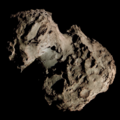C/1894 G1 (Gale)
Appearance
 Comet Gale (1894 II) photographed by Edward E. Barnard from the Lick Observatory on 5 May 1894 | |
| Discovery[1] | |
|---|---|
| Discovered by | Walter F. Gale |
| Discovery site | Sydney, Australia |
| Discovery date | 1 April 1894 |
| Designations | |
| 1894 II, 1894b[2] | |
| Orbital characteristics[3] | |
| Epoch | 4 June 1894 (JD 2412983.5) |
| Observation arc | 82 days |
| Number of observations | 45 |
| Aphelion | 176.85 AU |
| Perihelion | 0.983 AU |
| Semi-major axis | 88.914 AU |
| Eccentricity | 0.98298 |
| Orbital period | 838.42 years |
| Inclination | 86.959° |
| 207.89° | |
| Argument of periapsis | 324.17° |
| Mean anomaly | 0.060° |
| Last perihelion | 13 April 1894 |
| TJupiter | 0.124 |
| Earth MOID | 0.076 AU |
| Jupiter MOID | 1.230 AU |
| Physical characteristics[4] | |
| Comet nuclear magnitude (M2) | 6.3 |
| 3.0 (1894 apparition) | |
C/1894 G1 (Gale), also known formerly as 1894 II, is a long-period comet that became barely visible to the naked eye in May 1894. It is the first of three comets discovered by Australian astronomer Walter Frederick Gale.
Possible meteor shower
[edit]The comet's small minimum orbit intersection distance with Earth (0.076 AU) led scientists in 2021 to suggest that C/1894 G1 might potentially be the progenitor of a meteor shower known as the December Iota Ursae Majorids, however no definite link has yet been found between that particular shower and the comet.[5]
References
[edit]- ^ W. F. Gale (1894). "Beobachtungen des Cometen 1894… (Gale April 3)". Astronomische Nachrichten (in German). 135 (8): 149–150. doi:10.1002/asna.18941350805.
- ^ "Comet Names and Designations". International Comet Quarterly. Retrieved 23 May 2025.
- ^ "C/1894 G1 (Gale) – JPL Small-Body Database Lookup". ssd.jpl.nasa.gov. Jet Propulsion Laboratory. Retrieved 23 May 2025.
- ^ G. W. Kronk (2003). Cometography: A Catalog of Comets. Vol. 2: 1800–1899. Cambridge University Press. pp. 717–722. ISBN 978-0-521-58505-7.
- ^ M. Hajduková; L. Neslušan (2021). "Modeling the Meteoroid Streams of comets C/1894 G1 (Gale) and C/1936 O1 (Kaho–Kozik–Lis)". Planetary and Space Science. Bibcode:2021P&SS..19505152H. doi:10.1016/j.pss.2020.105152.
External links
[edit]- C/1894 G1 at the JPL Small-Body Database


